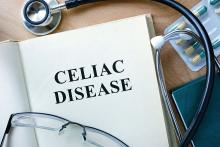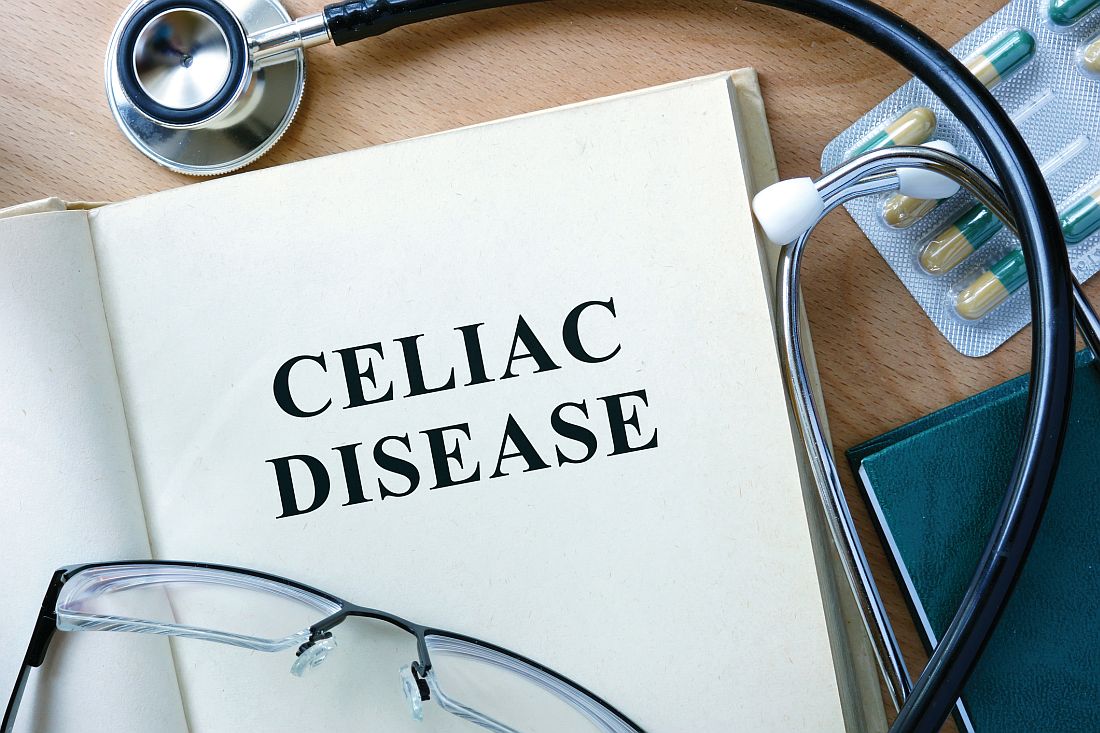User login
CHICAGO – A gluten-free diet is the cornerstone of treatment for celiac disease, but healing of the gut may take longer in some patients than in others.
New findings presented at the annual Digestive Disease Week suggest that, even though patients treated with a gluten-free diet generally experience clinical improvement during the first few weeks or months of making dietary changes, serologic and especially histologic normalization may take longer – and it is not always certain that it will occur.
As many as 45% of patients exhibit substantial differences in the degree of intestinal injury in separate biopsies. Thus, caution is needed when interpreting the results of individual biopsies when assessing healing in patients who are on gluten-free diets, explained Dr. Choung. Evaluating multiple biopsies “may give a more accurate picture of the mucosal healing,” he noted.
The degree of intestinal damage varies considerably in individuals with celiac disease, and this variability can affect accurate assessments of both recovery and residual injury in patients who continue to have persistent symptoms despite adherence to a gluten-free diet.
The goal of the current study was to evaluate uniformity versus patchiness of mucosal damage in a large cohort of patients with celiac disease who were being treated but who still experienced symptoms.
The study included 1,352 patients with celiac disease who had been on a gluten-free diet for at least 1 year and who had undergone four biopsies from the distal duodenum. Each biopsy was processed separately, and, in each one, the villous height (Vh) and crypt depth (Cd) were measured in up to three different, well-oriented crypts.
The mucosal patchiness of villous atrophy was then defined as a variation in Vh:Cd ratio between biopsies from the same patient that was greater than two standard deviations of the Vh:Cd variations of the study population (mean of Vh:Cd, 2.13; standard deviation, 0.67).
Of the 1,125 patients who had at least five crypts that were measured from all four biopsies, 45% met the criteria for histological patchiness of mucosal healing in the small intestine. The authors found that several factors, including a younger age at diagnosis, female gender, and a higher average Vh:Cd ratio, were positively associated with mucosal patchiness.
However, there were no significant associations observed between mucosal patchiness and the duration of a gluten-free diet or of any gastrointestinal symptoms.
When the analysis was restricted to the population with a Vh:Cd no greater than 2, Dr. Choung and his colleagues found that human leukocyte antigen typing and tissue transglutaminase–immunoglobulin A did not predict mucosal patchiness. However, patients who were positive for deamidated gliadin peptide–IgA or deamidated gliadin peptide–IgG were less likely to exhibit patchiness but had more uniform intestinal injury (odds ratio, 0.4 and 0.4, respectively).
Digestive Disease Week is jointly sponsored by the American Association for the Study of Liver Diseases (AASLD), the American Gastroenterological Association (AGA) Institute, the American Society for Gastrointestinal Endoscopy (ASGE) and the Society for Surgery of the Alimentary Tract (SSAT). Dr. Choung declared no relevant disclosures.
CHICAGO – A gluten-free diet is the cornerstone of treatment for celiac disease, but healing of the gut may take longer in some patients than in others.
New findings presented at the annual Digestive Disease Week suggest that, even though patients treated with a gluten-free diet generally experience clinical improvement during the first few weeks or months of making dietary changes, serologic and especially histologic normalization may take longer – and it is not always certain that it will occur.
As many as 45% of patients exhibit substantial differences in the degree of intestinal injury in separate biopsies. Thus, caution is needed when interpreting the results of individual biopsies when assessing healing in patients who are on gluten-free diets, explained Dr. Choung. Evaluating multiple biopsies “may give a more accurate picture of the mucosal healing,” he noted.
The degree of intestinal damage varies considerably in individuals with celiac disease, and this variability can affect accurate assessments of both recovery and residual injury in patients who continue to have persistent symptoms despite adherence to a gluten-free diet.
The goal of the current study was to evaluate uniformity versus patchiness of mucosal damage in a large cohort of patients with celiac disease who were being treated but who still experienced symptoms.
The study included 1,352 patients with celiac disease who had been on a gluten-free diet for at least 1 year and who had undergone four biopsies from the distal duodenum. Each biopsy was processed separately, and, in each one, the villous height (Vh) and crypt depth (Cd) were measured in up to three different, well-oriented crypts.
The mucosal patchiness of villous atrophy was then defined as a variation in Vh:Cd ratio between biopsies from the same patient that was greater than two standard deviations of the Vh:Cd variations of the study population (mean of Vh:Cd, 2.13; standard deviation, 0.67).
Of the 1,125 patients who had at least five crypts that were measured from all four biopsies, 45% met the criteria for histological patchiness of mucosal healing in the small intestine. The authors found that several factors, including a younger age at diagnosis, female gender, and a higher average Vh:Cd ratio, were positively associated with mucosal patchiness.
However, there were no significant associations observed between mucosal patchiness and the duration of a gluten-free diet or of any gastrointestinal symptoms.
When the analysis was restricted to the population with a Vh:Cd no greater than 2, Dr. Choung and his colleagues found that human leukocyte antigen typing and tissue transglutaminase–immunoglobulin A did not predict mucosal patchiness. However, patients who were positive for deamidated gliadin peptide–IgA or deamidated gliadin peptide–IgG were less likely to exhibit patchiness but had more uniform intestinal injury (odds ratio, 0.4 and 0.4, respectively).
Digestive Disease Week is jointly sponsored by the American Association for the Study of Liver Diseases (AASLD), the American Gastroenterological Association (AGA) Institute, the American Society for Gastrointestinal Endoscopy (ASGE) and the Society for Surgery of the Alimentary Tract (SSAT). Dr. Choung declared no relevant disclosures.
CHICAGO – A gluten-free diet is the cornerstone of treatment for celiac disease, but healing of the gut may take longer in some patients than in others.
New findings presented at the annual Digestive Disease Week suggest that, even though patients treated with a gluten-free diet generally experience clinical improvement during the first few weeks or months of making dietary changes, serologic and especially histologic normalization may take longer – and it is not always certain that it will occur.
As many as 45% of patients exhibit substantial differences in the degree of intestinal injury in separate biopsies. Thus, caution is needed when interpreting the results of individual biopsies when assessing healing in patients who are on gluten-free diets, explained Dr. Choung. Evaluating multiple biopsies “may give a more accurate picture of the mucosal healing,” he noted.
The degree of intestinal damage varies considerably in individuals with celiac disease, and this variability can affect accurate assessments of both recovery and residual injury in patients who continue to have persistent symptoms despite adherence to a gluten-free diet.
The goal of the current study was to evaluate uniformity versus patchiness of mucosal damage in a large cohort of patients with celiac disease who were being treated but who still experienced symptoms.
The study included 1,352 patients with celiac disease who had been on a gluten-free diet for at least 1 year and who had undergone four biopsies from the distal duodenum. Each biopsy was processed separately, and, in each one, the villous height (Vh) and crypt depth (Cd) were measured in up to three different, well-oriented crypts.
The mucosal patchiness of villous atrophy was then defined as a variation in Vh:Cd ratio between biopsies from the same patient that was greater than two standard deviations of the Vh:Cd variations of the study population (mean of Vh:Cd, 2.13; standard deviation, 0.67).
Of the 1,125 patients who had at least five crypts that were measured from all four biopsies, 45% met the criteria for histological patchiness of mucosal healing in the small intestine. The authors found that several factors, including a younger age at diagnosis, female gender, and a higher average Vh:Cd ratio, were positively associated with mucosal patchiness.
However, there were no significant associations observed between mucosal patchiness and the duration of a gluten-free diet or of any gastrointestinal symptoms.
When the analysis was restricted to the population with a Vh:Cd no greater than 2, Dr. Choung and his colleagues found that human leukocyte antigen typing and tissue transglutaminase–immunoglobulin A did not predict mucosal patchiness. However, patients who were positive for deamidated gliadin peptide–IgA or deamidated gliadin peptide–IgG were less likely to exhibit patchiness but had more uniform intestinal injury (odds ratio, 0.4 and 0.4, respectively).
Digestive Disease Week is jointly sponsored by the American Association for the Study of Liver Diseases (AASLD), the American Gastroenterological Association (AGA) Institute, the American Society for Gastrointestinal Endoscopy (ASGE) and the Society for Surgery of the Alimentary Tract (SSAT). Dr. Choung declared no relevant disclosures.
AT DDW
Key clinical point:
Major finding: Patients positive for DGP-IgA or DGP-IgG were less likely to exhibit patchiness but had more uniform intestinal injury (odds ratio, 0.4 and 0.4, respectively).
Data source: 1,352 patients with celiac disease who had been on a gluten-free diet for at least 1 year and who had undergone four biopsies from the distal duodenum.
Disclosures: Dr. Choung declared no relevant disclosures.

